This May, we’re taking a look at the fourth (and final) season of Star Trek: Enterprise. Check back daily for the latest review.
The Kir’Shara trilogy is the strongest three-parter of Star Trek: Enterprise‘s fourth season. It could legitimately be argued that the Kir’Shara trilogy is the strongest story of the entire season and one of the strongest stories of the show’s four-season run.
There are a lot of reasons why this is the case. The Kir’Shara trilogy makes great use of the franchise’s continuity and history, without getting too tied down into references for the sake of references. Indeed, there is a valid argument to be made that the trilogy represents the most overt rewriting of continuity across the fourth season, an ironic touch for a season so committed to continuity. The story does excellent work the show’s under-utilised supporting cast. The adventure actually merits three episodes, the story never dragging or wandering off on tangents.

Under a not quite blood red sky…
However, a large part of why this trilogy of episodes works better than the Borderland trilogy or the United trilogy is a simple piece of structuring. The Kir’Shara trilogy has a very clear and linear three-act structure, with each of the three episodes fitting comfortably together while doing their bit to advance and escalate the plot. There are no strange structural detours like the siege in Cold Station 12 or the visit to Andoria in The Aenar. Each of these three episodes is recognisable part of a singular larger story that builds to a crescendo.
The Forge does an excellent job setting up the arc, Awakening does an excellent job raising the stakes, and Kir’Shara does an excellent job tying it all together. The result is a satisfying two-hour television movie broadcast in three forty-minute chunks.

Mapping out an adventure…
There is a reason that the three act structure has endured for so long. Despite the debate and criticism that the form has prompted from scholars and industry veterans, it is not a bad way to structure a story. The theory can be traced back more than two millennia to Aristotle’s The Poetics:
The construction of its stories should clearly be like that in a drama; they should be based on a single action, one that is a complete whole in itself, with a beginning, middle, and end, so as to enable the work to produce its own proper pleasure with all the organic unity of a living creature.
While its debatable about whether this is the only way to tell a story, and how flexible that format is or how successfully it might be deconstructed, the truth is that it remains a solid template around which a story might be built. It is perhaps telling that even meta-stories adhere to the pattern, with an emphasis on trilogies over duologies.

The show is already dead.
Given that the fourth season of Enterprise has opted to tell its stories across multiple episodes in an effort to amortise the budget and allow for a larger scale, it makes sense to structure these larger three-part stories in this way. In fact, it is strange that the Kir’Shara trilogy is the only one of the three fourth-season trilogies to adopt that basic outline. Both the Borderland and United trilogies go out of their way to avoid it; both of the other two three-part stories often seem to be slowing down or extending what is essentially a two-part story.
For example, Borderland delays the start of the story somewhat; that first episode throws Archer into conflict with the Orion Syndicate for about thirty minutes before he comes face-to-face with Malik, while simultaneously devoting time to Malik’s efforts to assume command of the Augments. Cold Station 12 takes a detour to the eponymous research facility. Similarly, most of the plot threads from Babel One are resolved by the end of United, which means that The Aenar serves as an extended epilogue to the arc following one single thread instead of the larger story.

Things come to a head.
In contrast, the three parts of the Kir’Shara trilogy fit together in a more organic and unified manner, which seems appropriate given that the story is essentially about healing a schism in Vulcan culture. The Forge opens with a Vulcan discovering the katra of Surak before seguing to an embassy bombing on Vulcan. Awakening finds Archer embroiled in a potential civil war on Vulcan as tensions escalate and a conspiracy is unearthed. Kir’Shara finds Archer and Trip racing against time to stop a war from consuming the Vulcan people.
In fact, the smoothness with which the story flows is best illustrated by the two cliffhangers that bridge the three episodes. Neither of the cliffhangers is particularly visceral. There is none of the immediacy of the forced “everybody’s going to die!” ending of Cold Station 12 or the contrived “we’re going to accelerate until we explode!” conclusion of Affliction. At the same time, there is none of the game-changing effectiveness that underscored the best cliffhangers on Star Trek: Deep Space Nine. Instead, the cliffhangers are more matter-of-fact and plot-driven.

Archer has a close shave.
The Forge ends with Archer and T’Pol arriving at the T’Karath Sanctuary only to be ambushed by the Syrranites. It is hardly a surprise, given where the plot is going. More than that, Archer even warns T’Pol that they are about to be captured. “Don’t resist,” he advises. Awakening ends with Trip forced to abandon Archer on Vulcan and facing the prospect of a war between the Vulcans and Andorians. Neither ending is shocking or startling. Both are entirely organic and feel like reasonable development for the story at that point; more act breaks than episode cliffhangers.
The nature of television production means that there are delineations between the episodes. This is reflected in the casting, for example; various characters only appear in particular episodes of the trilogy rather than carrying across the trilogy. For the most part, this works well. Signing Michael Nouri for The Forge rather than Awakening or Kir’Shara allows Syrran to play the role of trickster mentor before he dies. Signing Kara Zediker for Awakening and Kir’Shara rather than The Forge means the first part of the trilogy is a forty-minute build-up to T’Pau’s appearance.

The bomb went T’Pau…
The story is generally quite clever in how it uses particular characters, demonstrating just how careful Manny Coto and his production team were with the budget. The character of Stel is revealed as the bomber at the end of The Forge, which serves to escalate the tension between act breaks and also means that the production team do not have to pay Larc Spies to reappear in Awakening. Although the decision to explain the character’s fate through exposition from Administrator V’Las is a little conspicuous, it is still a very practical budget-saving storytelling tool.
The storytelling flows easily enough between parts. The Forge is very much centred on the aftermath of the terrorist attack on the Earth embassy, following T’Pol and Archer as they wander out into the desert in search of the Syrrannites. The structuring here is quite clever. This initially seems like padding in the style of the encounter with the Orions in Borderland, a way for the story to delay Archer’s first encounter with the Syrrannites by giving him a plot that will eat up screentime as everything else moves into position.

Valley Forge.
However, The Forge very cleverly capitalises on this assumption by allowing Archer to come face-to-face with the leader of the movement almost immediately. In fact, Archer spends a significant amount of time with Syrran in the first episode of the trilogy. However, the episode structures these sequences in such a way that the identity of Archer’s fellow traveller is not revealed until Awakening. It is a very clever sleight of hand, one that plays with the way that Enterprise had structured its first three-part story.
The Forge feeds rather elegantly into Awakening. Archer’s journey through the desert does bring him into contact with the Syrrannites. The conspiracy within the Vulcan High Command is elaborated upon and expanded. The prejudice against the Syrrannites that T’Pol referenced in The Forge is rendered explicit (and escalated) in Awakening. The stakes are raised. The outline that was defined in The Forge is further refined in Awakening, with all of its plot developments growing organically from the set-up in the first part of the story.
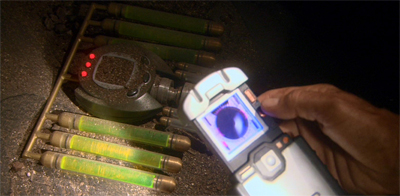
“Sensors confirm. The red lights are not a good thing.”
That said, the transition between Awakening and Kir’Shara is a little rougher. While The Forge worked very hard to set up all of the revelations in Awakening, the plans to invade Andoria in Kir’Shara seem to come out of nowhere. They are dropped into the last act of Awakening with no really foreshadowing or set-up. Towards the end of the episode, Soval suddenly informs Trip that Administrator V’Las is persecuting the Syrrannites as an attempt to silence opposition before launching an invasion. It feels like something that might have been important earlier.
There are obvious practical reasons why the reveal was delayed and held back. Most obviously, Jeffrey Combs only appears in the final episode of the trilogy. There is some strain in the early acts of Kir’Shara as all the characters arrive on the same page; most awkwardly, the script has to bring Archer and T’Pol up to speed, despite being cut off from Soval and Enterprise. As T’Pol quite correctly nitpicks, “Assuming for the moment you possess Surak’s katra, he’s been dead for centuries. How could he be aware of plans for a war?”
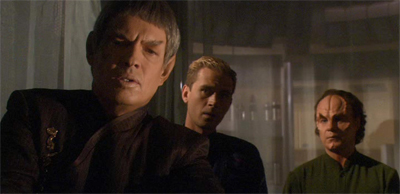
“And/or war.”
Archer dismisses the criticism, suggesting that Syrran knew. However, it seems strange that this becomes so vitally important for all of the major characters at exactly the same point in the plot. It might have been more efficient to set up the looming conflict between Vulcan and Andoria with a few lines of dialogue in The Forge, or a couple of off-hand references to the Vulcan High Command’s increased militarism. It is more than slightly contrived that V’Las goes from wiping out the Syrrannites to staging invasion briefings in what appears to be a matter of minutes.
Still, this is a relatively minor complaint in the grand scheme of things. There is certainly a smoother transition between individual episodes in the Kir’Shara trilogy than any of the other three-part episodes in the fourth season. In fact, it could be argued that the transition is smoother between these three episodes than between Affliction and Divergence or In a Mirror, Darkly, Part I and In a Mirror, Darkly, Part II. It is a testament to the production team that their second attempt at a three-parter should go so smoothly.

This is what happens when you plan ahead.
The three-parter also makes excellent use of the space afforded by spreading the story out. There are several wonderful sequences that are not necessary to the plot, and could probably have been trimmed if runtime became an issue, but which add a great deal to the story. The Forge is particularly lucky, having the luxury of spreading the story’s opening act across forty minutes. The Forge does not have to worry about paying off key plot points, so it can devoted time and energy to smaller character beats.
These beats serve tangible and practical purposes. The conversation between Ambassador Soval and Admiral Forrest in the opening scene helps to create a sense of tangible growth for both characters, to highlight certain themes of the three-parter, and to give additional resonance to Forrest’s death. Although the episode could have been produced with Forrest’s death taking place off-screen, sparing the expense of hiring Vaughn Armstrong, the entire story would have been much weaker for it.

“Vulcan is in danger. Maybe the greatest danger it’s faced since the last world war. Something has to be done about these Andorians.”
There is also the luxury of spending a little extra time with the crew. Archer is playing basket ball with his senior staff when he receives word from Vulcan, a little detail that emphasises how little time Enterprise has allowed its primary cast to socialise together. Similarly, the scene with Reed and Mayweather exploring the site of the bombing might go on a little longer than necessary, but it feels like the most that Mayweather has gotten to do in a very long time. It harks back to the way that first season episodes would allow time for these tangents.
The fourth season engages with the show’s ensemble for the first time since the earliest stretch of the first season. Home might have struggled because the show’s cast is largely two-dimensional, but the fourth season makes a conscious effort to give everybody in the cast something to do. Reed gets a bit of character development in Affliction and Divergence, and even Mayweather gets his own story thread in Demons and Terra Prime. It is not a lot, but it does suggest that the fourth season was hopeful of developing the cast of characters further that earlier years had been.

Mayweathering the storm…
The extra room afforded to The Forge (and to the trilogy in general) means a greater emphasis on the show’s supporting cast. No Star Trek show has ever had a deeper ensemble than Deep Space Nine, with dozens of complex and engaging recurring characters who served to flesh out the world. However, Enterprise has been gifted with a number of superb supporting actors in important secondary roles that have largely been wasted or underutilised. The Kir’Shara trilogy brings several of those characters back to the fore.
It is astonishing to think that Jeffrey Combs only appeared as Shran in five episodes across the entirety of the first three seasons of Enterprise. The actor is brilliant, and the character is fascinating. Allowing both to gather dust on the shelf is a spectacular error in judgement, akin to ignoring characters like Garak or Dukat or Weyoun on Deep Space Nine. Shran’s reappearance in Kir’Shara signals a renewed interest in the character. In fact, Shran appears five times over the course of the fourth season; as frequently as he did in the previous three seasons combined.

If a pillar falls on the Forrest…
However, The Forge also makes great use of the show’s other recurring characters. This marks the last appearance of Vaughn Armstrong as Admiral Forrest, barring the reappearance of his mirror universe counterpart in In a Mirror, Darkly, Part I. Armstrong gives Forrest an understated decency and integrity that bleeds through in his single scene at the start of the episode. However, the trilogy is very much a showcase for actor Gary Graham, who is finally allowed to present Ambassador Soval as more than just a two-dimensional foil.
Soval has recurred on the show since Broken Bow. However, the character has always been portrayed as antagonistic and bureaucratic. Across the first three seasons of the show, Soval’s primary function was to insist that humans were not ready for space travel so that Archer might be motivated to prove him wrong. That is a very generic character beat, even if episodes like Twilight found a way to use that in an interesting manner. The Forge gives Soval a character arc, and some development. He becomes a more nuanced and compelling character.
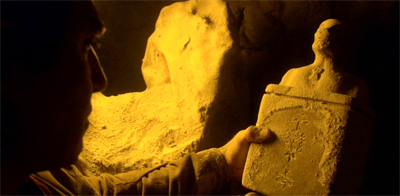
Raiders of the lost katric ark…
Vulcans can be a difficult species, for both writers and actors. The key to portraying a Vulcan is to understand that they are not emotionless. Vulcans repress their emotions, burying them beneath the surface. That does not mean that they are entirely rational or stoic, no matter what their culture might suggest. They are not robots. That creates a fine line for writers and actors trying to characterise Vulcans, with the species capable of profoundly strong emotions but also struggling to keep them bottled up. A performance can easily go too far one direction or the other.
The Forge generally does quite well with its Vulcan performers. Gary Graham understands this aspect of the Vulcan character, channelling Leonard Nimoy in his portrayal of a man clearly driven by emotion however much he might deny it. The scene between Archer and Soval over Forrest’s coffin is a wonderful piece of writing and performance, with Soval clearly motivated by emotion while unwilling to acknowledge it. It is a moment with surprising emotional power, precisely because it is not overplayed.
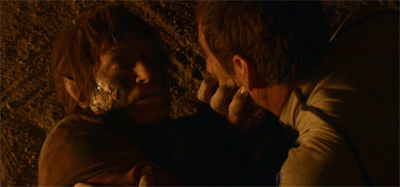
“Remember…”
Similarly, Robert Foxworth portrays V’Las as a Vulcan struggling even harder to suppress his emotions, at one point turning away while having a strong emotional reaction to the revelation that Soval is a melder. The final scene of Kir’Shara presents V’Las as something of an ambiguous figure. It is never entirely clear whether V’Las is actually Romulan or if he is simply aligned with Romulan interests. Foxworth’s performance seems to suggest that V’Las might actually be a Romulan trying to blend in with his fellow Vulcans.
Michael Nouri does great work as Syrran. Although his identity is hidden until Awakening, Nouri is very much cast in the role of an idealised Vulcan. Much like Graham, Nouri’s performance suggests an understanding of the Vulcan character as defined by Leonard Nimoy forty years earlier. Syrran is not an emotionless robot. In fact, there are any number of subtle emotional cues peppered through Nouri’s performance; in particular, his affectionate half-smile while eating dinner with Archer and T’Pol. However, there is also sense of dignity and remove. It works well.

Taking the “ass” out of “ambassador.”
The Forge is also notable for being the first episode of Star Trek to be written by Judith and Garfield Reeves-Stevens. The duo were veteran writers who had started writing education textbooks together in Canada, but who had later moved into the world of fiction. Catching a screening of Star Trek IV: The Voyage Home, the pair decided to try their hands at writing tie-in Star Trek fiction and non-fiction. With books like Prime Directive and Federation, the two writers established as two of the stronger tie-in writers.
The Reeves-Stevens also enjoyed a closer relationship with the establishment than many of their contemporaries at Pocket Books. The pair were granted unprecedented behind-the-scenes access to draft The Making of Star Trek: Deep Space Nine, the high-profile insight into the creation and history of the second spin-off that was published in 1994. The Reeves-Stevens also enjoyed a long-term working relationship with William Shatner, co-writing many of his own tie-in Star Trek novels.
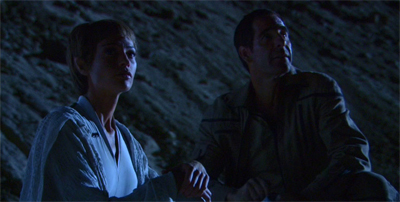
Just deserts…
With the threat of cancellation looming, the Enterprise production team had suffered considerable attrition. Veteran writers like David Goodman and Chris Black had left, with Manny Coto managing a room that was heavily understaffed. In Before Her Time, Coto recalls the challenges that he was facing and why he specifically sought out the Reeves-Stevens:
Coming into season four, a good number of the writers had left. And, basically, having been charged with running the writers’ room, I knew we had to kind of replace writers and bring in new writers. I’d noted the Reeves-Stevens’ work. I had read Federation, which I though was tremendous. Really great, and I’m not a big reader of Star Trek novels. But somebody had recommended it, I read it, it was tremendous. I had read of them, and I knew that they had a vast knowledge of the Star Trek universe. More than myself. I knew I needed writers who – since this was what we were going to delve into – writers who were experienced television writers, but who also had a great knowledge and passion for the Star Trek universe. And I met with them, and loved them. I realised this was a perfect addition. I wanted to do in season four, kind of Star Trek novels, in a way, for television. And so, in that respect, I wanted novelists to be on staff. So they were perfect.
Given the attention that the fourth season pays to the origin of the Federation, it made perfect sense to invite Judith and Garfield Reeves-Stevens on staff. Their most celebrated Star Trek novel was probably Federation, a book that fashioned together a complete and comprehensive history of that most essential Star Trek institution from the references scattered across the length and breadth of the franchise.
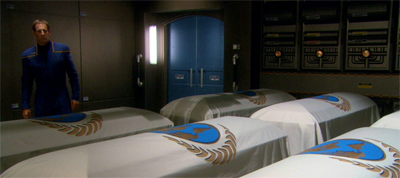
Coffin up for a lot of flags.
The Reeves-Stevens arrived at a moment of panic on the series. They were invited on staff while Home was in production and The Augments was being scripted. They would be writing the very next script. Judith gives a sense of the kind of pressure behind the scenes:
Then we got a call saying, “Can you come in right away?” We went in and were writing on the show within two weeks. They were shooting the third episode of Season 4, working on six in the writers’ room and then we wrote episode seven, The Forge. We ended up writing or co-writing five episodes out of 22, so we wrote practically a quarter of the season. It was all about laying the foundation for the original Star Trek — the Vulcan Reformation, the beginnings of the Federation.
That story recalls Coto’s own arrival on the series. Coto had been hired early in the third season, expecting the opportunity to acclimatise to his surroundings. Instead, the writer was immediately tasked with scripting the episode that would become Similitude. It seems that writing for Enterprise was very much a trial by fire.

A touching reunion…
The Reeves-Stevens have a rich and varied career history that includes everything from textbooks to animation to live action television. Nevertheless, their writing feels very much rooted in a novelist’s perspective; their work has a keen attention to detail that extends beyond that traditionally found on network television. Although The Forge is never burdened with exposition, it devotes a lot of attention to fleshing out the world and its characters. It is to the credit of the Reeves-Stevens that the episode does this without ever dragging or distracting from the story.
There are several wonderful little touches, such as Syrran explaining the meaning of the IDIC symbol to Archer and T’Pol over dinner. The triangle within the circle represents Mount Seleya, which is cleverly incorporated into Vulcan mythology here; both through the revelation that “Surak died on Mount Seleya” and through clever touches like the mural of the mountain visible in the background of the Vulcan High Command in both Awakening and Kir’Shara. It is a great example of how wonderfully realised the Star Trek universe is.
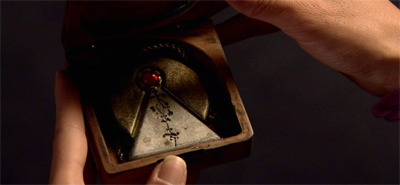
I had no IDIC what it represented…
For the duo, part of the excitement of writing for Star Trek was the opportunity to tie these sorts of details together and fashion a more cohesive fictional world. As Garfield explains, the idea for The Forge originated in that speech tying the IDIC to Mount Seleya:
When we went in to pitch the story for The Forge, Brannon said, “People have been pitching me Vulcan IDIC [the basis of Vulcan philosophy] stories for years, and I’ve never liked any of then until this one.” So that was nice. With 200 years of Star Trek history, we thought it was time for someone to write a James Clavell novel tying the story of the IDIC to [the sacred Vulcan mountain] Mount Seleya. It was a privilege to be the ones to do that.
The fourth season of Enterprise is fixated on tying strands of continuity together; Klingon ridges and Khan Noonien Singh in Divergence, The Tholian Web and Mirror, Mirror in In a Mirror, Darkly, Part I. These can often feel forced or contrived. The Forge is a great example of tying those threads together organically.

High in stature.
There are lots of other little nice touches buried in The Forge that help to suggest Vulcan as a fully-formed world. In particular, the three-parter very heavily implies that the eponymous desert region is the result of the planet’s history of nuclear conflict. When T’Pol talks about the “reflected heat”, the Reeves-Stevens originally intended for the character to talk about plains of green glass forced in atomic explosions, similar to the “Trinitite” that was created during the Trinity tests in the forties. Sadly, the budget would not stretch to rendering those effects.
The Forge is a wonderful piece of Star Trek and the start to one of the strongest stories in the entire four-season run of Enterprise. It is a pretty great introduction for Judith and Garfield Reeves-Stevens, and also easy to see why Manny Coto cites the story as his favourite from his tenure as showrunner.
You might be interested in our other reviews of the fourth season of Star Trek: Enterprise:
- Storm Front, Part I
- Storm Front, Part II
- Home
- Borderland
- Cold Station 12
- The Augments
- The Forge
- Awakening
- Kir’Shara
- Daedalus
- Observer Effect
- Babel One
- United
- The Aenar
- Affliction
- Divergence
- Bound
- In a Mirror, Darkly, Part I
- In a Mirror, Darkly, Part II
- Demons
- Terra Prime
- These Are the Voyages…
Filed under: Enterprise | Tagged: Alice Eve, Andorian, games, james t. kirk, Jonathan Archer, khan, Klingon, List of Star Trek characters (G–M), Math, star trek, StarTrek, Surak, Tellarite, Trekkie, vulcan, Vulcans |




















I’ve seen a lot of people say they really like this three parter and consider it their favorite, I slightly disagree. I like it a lot, but the fact it brings back the Katra spirit goofiness brings it a bit down for me. However, I heavily like the fact it corrected the whole “Vulcans are total assholes” issue with ENT, and adds a nod to the whole Romulan unification plot from TNG. I prefer the United three parter a bit more though.
Btw, I don’t care about all the continuity issues with the Vulcans as much as the way they portrayed them largely was very badly handled and written, hence why I appreciate what this three parter did. But it’s the final season so guess it doesn’t matter.
Apparently, according to Memory Alpha, the Kir’Shara appears in the first Abrams Trek film, so this three parter certainly had an impact on the fandom.
Yep, I’ll talk about the continuity thing on Monday in the Kir’Shara review.
But what I really like about the Kir’Shara trilogy is that it’s an example of an episode where strict continuity is brushed aside to serve the show itself. Making the Vulcans friendly would seem to explicitly contradict the other shows, but it really feels like an organic storytelling decision for Enterprise itself.
The problem with ENT is it completely rewrote the Vulcans without any explanation. For example they don’t know what mind melding is largely until this three parter (while good, is simply a forced last minute “we’re fixing the continuity issues” storyline so ENT doesn’t confuse fans in the long run any further), something never hinted at ever in Star Trek. In reality, despite being a massive enough Trek fan to have actually played Star Trek Online and plan to visit the Trek Mecca convention in Vegas, I actually don’t really care about this from a continuity standpoint, I could care less. It’s just very badly written throughout the series, thereby not justifying it taking a massive shit on the canon. One of the many deep flaws that make ENT one of the weakest, if not the weakest, of all the series.
I like the katric elements, if only because it’s a better way of doing the whole “Vulcan-human hybrid” thing that the forced “Trip-T’Pol romance and stolen DNA” plot. If the fourth season wants to hint at the birth of Spock as the moment that the Star Trek universe kinda comes into existence, which is a very reasonable approach for a prequel to take, the idea of making the hybrid metaphorical rather than literal seems a lot less clunky than Paxton’s “designer baby of DOOM!”
Well technically speaking, I imagine any human alien mating producing a viable child is ridiculous, perhaps just as ridiculous as ghosts in an otherwise science based universe. Though I think ENT actually goes out of its way to somewhat address how awkward and weird interspecies childbirth would be, or do they handwave it away? I forget.
Regardless, I think Katras belong more in Star Wars than Star Trek. They do after all only appear elsewhere in one of the silliest and goofiest entries in the entire franchise (Star Trek 3: The Wrath of Doc Brown)
Also I like the Baby T’Pol plot and the Terra Prime arc in general. I’m a sucker for interspecies romance and allegories on racism.
Whoa, whoa. Forrest DIED?
I missed this trilogy entirely.
“V’Las might actually be a Romulan trying to blend in with his fellow Vulcans.”
Yes, I seem to recall talk of T’Pol being ‘outed’ as Romulan in the unfilmed season 5.
I have a reference book that says V’Las was some Romulan agent, but I doubt it’s “canon”
David A. Goodwin, a staff writer on the second and third seasons, included it in his wonderful History of the Federation book. Which is not canon, but is still fun. It has an introduction – in character! – from George Takei!
(I’m not a big fan of “canon”, as the reviews might make clear. I understand its utility in a basic “we have to establish very basic storytelling rules”, but I also enjoy the idea of multiple interpretations that illuminate or enlighten one another.)
That’s the book. I don’t care about canon either, I just bought it because I liked the artwork and take on Trek history.
Ha! I guess you could say you didn’t see the Forrest for the trees, eh?
I’ll show myself out.
But yeah, Sussman wanted to make T’Pol at least half-Vulcan. Which I think would have been a nice way to tailor the role to Blalock’s performance. She really is the most emotional significant Vulcan in the franchise’s history. Spock was half human and still held it together better. (Although, in Blalock’s defense, I do respect her for trying to do something more than “impersonate Leonard Nimoy” with the role.)
Again this shows where I don’t care about canon. It’d be cool IMO if she were half Romulan, because I like the Romulans. No other reason.
It is a very clever sleight of hand, one that plays with the way that Enterprise had structured its first three-part story. — Except it’s not Enterprise’s first three-parter. That honor belongs to the Augment trilogy we just finished.
Yep. The text makes that clear, it’s referring to how the structure of the Kir’Shara trilogy is different from the structure of the Augments trilogy.